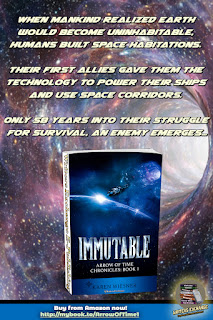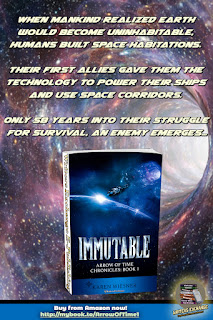Surprise
#1: Of Not Having to Reinvent the Wheel For Everything
This is the third of fifteen posts
dealing with surprising things I learned in the course of writing a science
fiction series.
In the first part of this series, I mentioned that one of the
fundamentals I was told about the "right way" to write science
fiction was by adhering to what seemed to be to be the cardinal rule of the
genre: That all science fiction stories have to include a concept of legitimate
science or technology that can somehow be applied to fictional theories or
ideas that could become future realities. Without fail, every single writing
manual and article I read about how to write science fiction included this regulation.
This is in the same vein as "write what you know" but of course is it
really necessary or even ideal for a writer to limit himself in such a way?
[Read Margaret L. Carter's February 10, 2022 post about just this if you want a
unique look at this theory: https://aliendjinnromances.blogspot.com/2022/02/most-writers-are-writers.html]
I don't dispute that scientific and technologic realism are
important so much as I wonder how much it can be bent. We are writing fiction,
after all. In his Biographia Literaria,
William Coleridge coined the phrase "suspension of disbelief". In
this "poetic faith" state of mind, readers voluntarily ignore obvious
untruths and fantastic elements in order to enjoy the story unfolding before
them. So, if an author can legitimately make readers believe something that's
impossible in the real world is actually happening in the fictional story,
anything goes, right?
When an author goes into writing science fiction, there are a lot
of "Standard Operating Procedure" facts that have to be established
and explained about this time period and their unique world or universe--in a
way that readers are able to suspend belief and just go with it, regardless of
how implausible in our current world and time. For example, if your characters
travel through space on a regular basis, you usually have to explain how
they're doing it.
Luckily, many amazing authors have already written about
fascinating concepts based on scientific principles and existing and
experimental technology, such as using wormholes, folds in the fabric of space,
or some other creative explanation that provides the means of skipping, folding
or warping space to allow jumps across great distances--all that do factor in
the theory of relativity, time dilation, and interstellar travel. I call these
"established knowns", and they provided one of the first surprises I
received when I started writing science fiction. Namely that I could use these "established
knowns" because they're basically plausible explanations that are already
accepted by the majority of science fiction readers who devour extremely
popular science fiction books, movies, and television series like Star Trek, Star Wars, Mass Effect,
and The Expanse. Cool! I needed to
hear the good news that there can be some shortcuts in this complicated
undertaking. But keep in mind that most writers don't want to and shouldn't use them verbatim. That would
be copying and could lead to all kinds of moral and legal issues. However,
simply basing your tech and world principles on established knowns is allowed.
You have to find a way to creatively adapt established knowns to make them
unique to your story and series.
Since my series was set in the not-to-distant future, I really did
have to have an explanation for how Humans got their technology to travel
through space. I creatively used some established knowns to explain their space
travel and communications, as well as coming up with realistic, futuristic
orbital habitations, credible revelations about dark energy and matter, and
legitimate reasons for what might force Humans to leave Earth to explore and
find homes in space or on other planets. All of these were treated as Standard
Operating Procedures for my series. Rather than reinventing the wheel for all
of these things, I laid down my foundations as simply and believably as I could
based on creatively adapted established knowns.
The surprise that I didn't have to reinvent the wheel for every
single scientific and technical aspect was certainly one of the most welcome I
had. It saves so much time and energy to utilize the concept of established
knowns. I realized almost from the start that forcing myself to come up with
brand new, exciting and extra creative ideas to explain the "SOP" of
my series would have been overwhelming not only for me as the author (having to
figure all this out when I'm most definitely not a scientist of any kind in the
real world!), but also overwhelming for the readers who would have to hear
endless and overly complex and potentially boring explanations about how
everything worked from A-Z here in my particular galaxy. I've found over the
years that the science fiction stories I like following the **least**
are the ones that spend way too much time trying to explain to me the Standard
Operating Procedures for their universe. I don't think I'm that different from
other sci-fi readers: In a fiction book or series, I want to be impressed by
the creativeness of the story, not scientific theories.
In Arrow of Time, the space travel and communication SOPs weren't
exactly the same as for any other series, and I think that's important because,
to me, just saying my characters have warp drive, like in Star Trek, felt like cheating. What I did was figure out what's
been done already and what's plausible, and, from there, I played around with
the concepts until they fit my series and made sense in it. Creatively
utilizing established knowns, I could put my SOPs in place as briefly and
intriguingly as possible and then I could roll out my story.
Another reason for not reinventing the wheel for every little
aspect of your science fiction story is that these things you labor to create
can easily become focal points. If that's what you intended, great. But if it's
not, you went to a lot of elaborate trouble to develop and explain them yet
they're not factoring greatly into the storyline somehow. That doesn't make
sense and could be frustrating for readers. In my series, those SOP aspects
weren't majorly important. I wanted them to be legitimate and credible, but I
didn't want them to call more attention to themselves than was necessary. All I
wanted was for the "poetic belief" to kick in for readers so I could
move forward with the storytelling.
Over the course of the next two weeks, we'll talk about research
and developmental tools in writing science fiction.
Happy writing!
Based
on Writing the Overarching Series (or How I Sent a Clumsy Girl into Outer Space): 3D Fiction Fundamentals Collection by Karen S. Wiesner (release date TBA)
https://karenwiesner.weebly.com/writing-reference-titles.html
http://www.writers-exchange.com/3d-fiction-fundamentals-series/
Karen Wiesner is an award-winning,
multi-genre author of over 140 titles and 16 series, including the romantic science fiction series,
ARROW OF TIME CHRONICLES
https://www.writers-exchange.com/arrow-of-time-chronicles/
https://karenwiesner.weebly.com/arrow-of-time-chronicles.html
http://www.facebook.com/KarenWiesnerAuthor







































